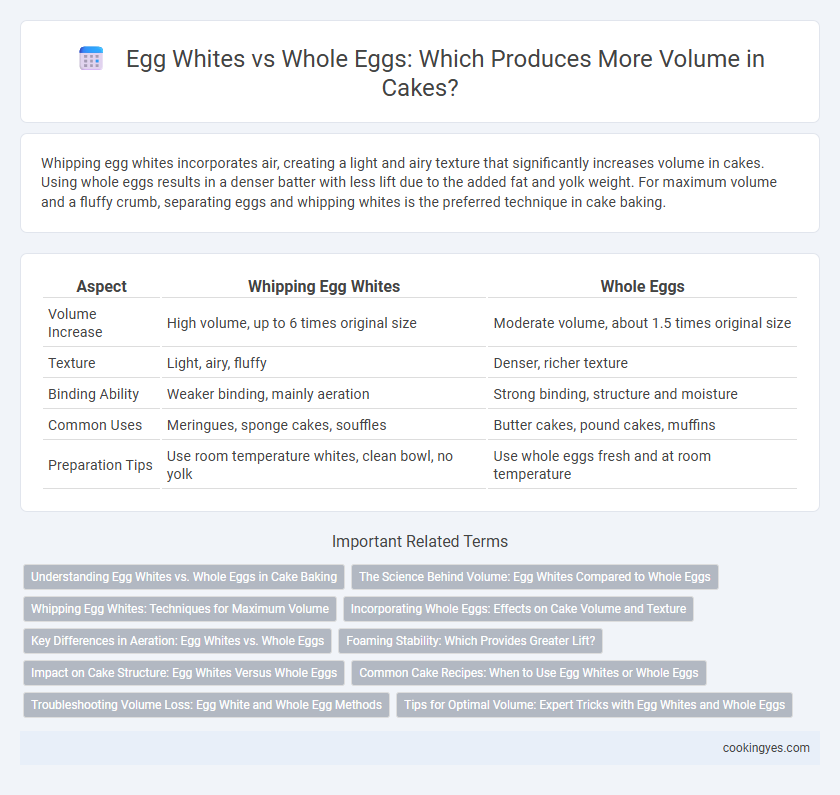Whipping egg whites incorporates air, creating a light and airy texture that significantly increases volume in cakes. Using whole eggs results in a denser batter with less lift due to the added fat and yolk weight. For maximum volume and a fluffy crumb, separating eggs and whipping whites is the preferred technique in cake baking.
Table of Comparison
| Aspect | Whipping Egg Whites | Whole Eggs |
|---|---|---|
| Volume Increase | High volume, up to 6 times original size | Moderate volume, about 1.5 times original size |
| Texture | Light, airy, fluffy | Denser, richer texture |
| Binding Ability | Weaker binding, mainly aeration | Strong binding, structure and moisture |
| Common Uses | Meringues, sponge cakes, souffles | Butter cakes, pound cakes, muffins |
| Preparation Tips | Use room temperature whites, clean bowl, no yolk | Use whole eggs fresh and at room temperature |
Understanding Egg Whites vs. Whole Eggs in Cake Baking
Whipping egg whites incorporates more air, creating a foam that significantly increases volume and lightness in cakes, essential for chiffon or sponge varieties. Whole eggs contain fat and emulsifiers that add richness and structure but do not trap air as effectively, resulting in denser cakes. Understanding the protein and fat content differences is crucial for optimizing texture and rise in baking recipes.
The Science Behind Volume: Egg Whites Compared to Whole Eggs
Egg whites provide greater volume in cake batters due to their unique protein structure, which traps air when whipped, creating a stable foam essential for leavening. Whole eggs contain fat in the yolks that can inhibit foam formation, resulting in less volume compared to egg whites alone. Understanding this protein-fat interaction helps bakers optimize texture and rise in cakes by adjusting egg composition.
Whipping Egg Whites: Techniques for Maximum Volume
Whipping egg whites to stiff peaks introduces air, creating a foam that significantly increases volume and results in lighter, fluffier cakes compared to using whole eggs. Key techniques for maximum volume include ensuring egg whites are at room temperature, adding a pinch of cream of tartar to stabilize the foam, and whipping at medium speed initially before increasing to high speed. Avoiding the presence of any fat or yolk in the whites and using a clean, grease-free bowl enhances the egg whites' ability to trap air effectively.
Incorporating Whole Eggs: Effects on Cake Volume and Texture
Incorporating whole eggs into cake batter enhances structure and moisture, contributing to a tender crumb while generating moderate volume compared to whipping egg whites. The fat in yolks emulsifies the batter, improving texture and richness but slightly reducing aeration potential relative to whipped egg whites. Whole eggs create a balanced combination of stability and softness, resulting in cakes with uniform rise and fine, moist texture.
Key Differences in Aeration: Egg Whites vs. Whole Eggs
Whipping egg whites incorporates more air, creating a lighter and fluffier texture due to the higher protein content that stabilizes air bubbles, whereas whole eggs contain fat in the yolks that inhibit maximum aeration. Egg whites can trap up to twice the volume of air compared to whole eggs, making them essential for recipes requiring significant rise and volume, such as angel food cakes. Whole eggs provide moisture, flavor, and richness but produce denser batters with less overall volume than whipped egg whites alone.
Foaming Stability: Which Provides Greater Lift?
Whipping egg whites creates a foam with greater volume and superior foaming stability compared to whole eggs, as the absence of yolk fats allows proteins to form a more resilient air network. Whole eggs produce a less stable foam due to the emulsifying properties of yolk lipids that inhibit maximum air incorporation. For cakes requiring maximum lift and lightness, egg white foam ensures enhanced volume and sustained structure during baking.
Impact on Cake Structure: Egg Whites Versus Whole Eggs
Whipping egg whites incorporates more air, resulting in a lighter, fluffier cake structure due to increased volume and aeration. Whole eggs contribute to a denser, richer cake texture by adding fat and emulsifiers that enhance moisture retention and stability. The choice between whipped egg whites and whole eggs significantly affects crumb tenderness and overall cake rise, with egg whites promoting loft and whole eggs providing firmness.
Common Cake Recipes: When to Use Egg Whites or Whole Eggs
Whipping egg whites incorporates air, creating a light and airy texture ideal for sponge cakes and angel food cakes, while whole eggs provide structure, moisture, and richness suitable for denser cakes like butter or pound cakes. Recipes requiring maximum volume and fluffiness rely on whipped egg whites to trap air, enhancing rise and tenderness. Whole eggs bind ingredients and contribute emulsification, making them preferable in most common cake recipes where a moist crumb and stability are desired.
Troubleshooting Volume Loss: Egg White and Whole Egg Methods
Whipping egg whites introduces more air and creates a stiffer foam, resulting in greater volume for cakes compared to using whole eggs, which contain fat that can inhibit aeration. Volume loss may occur if egg whites are not whipped to stiff peaks, are contaminated with yolk, or if sugar is added too quickly during whipping, compromising the foam's stability. Whole egg mixtures require careful folding and mixing to avoid deflating the batter, as overmixing or under-beating can lead to reduced lift and denser cake texture.
Tips for Optimal Volume: Expert Tricks with Egg Whites and Whole Eggs
Whipping egg whites achieves greater volume due to the incorporation of air, creating a light, fluffy texture essential for souffles and angel food cakes. Whole eggs provide richness and structure but generate less volume compared to separated whites whipped to stiff peaks. For optimal results, use room temperature eggs, add a pinch of cream of tartar to stabilize whites, and gently fold whipped whites into batter to preserve airiness without deflation.
Whipping egg whites vs Whole eggs for volume Infographic

 cookingyes.com
cookingyes.com